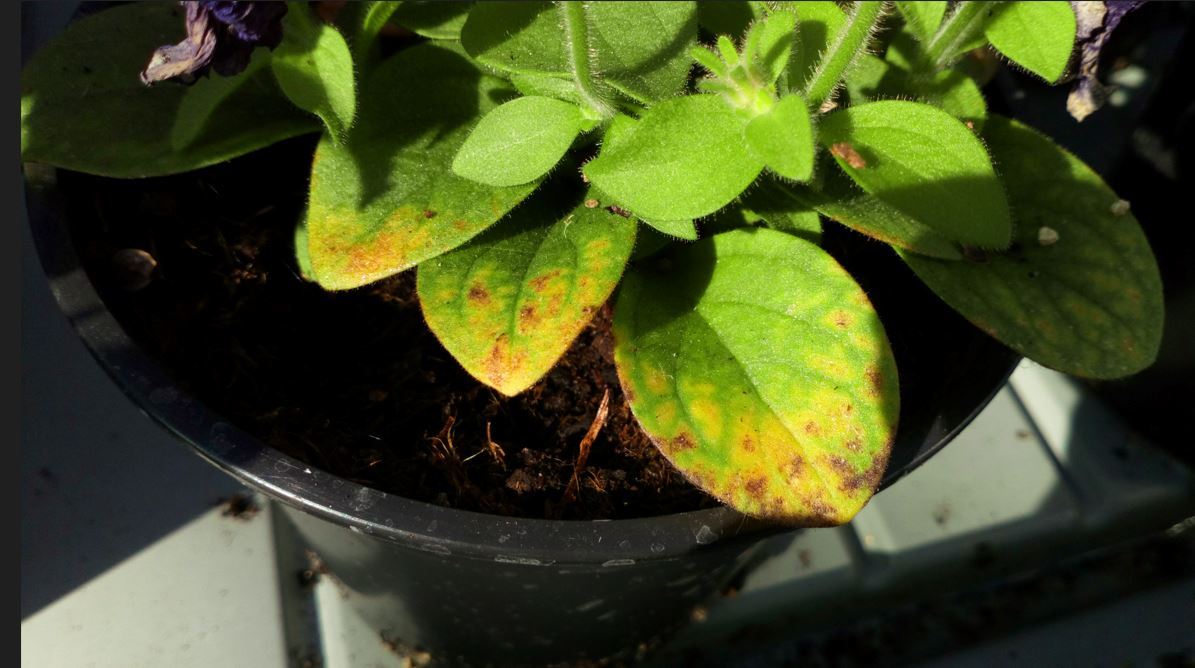Please click here to access the main AHDB website and other sectors.
- Home
- Knowledge library
- How to prevent or treat for iron deficiency in petunia and primula
How to prevent or treat for iron deficiency in petunia and primula
It is better to prevent nutrient deficiencies, like iron deficiencies in primula and petunia, rather than to treat them. It is easiest to use a best practice approach, like the one outlined below
Go back to the iron deficiency main page
Best practice advice for avoiding iron deficiency in petunia and primula
If you are in a hard water area and don’t treat your irrigation water to reduce the pH, follow these steps to avoid iron deficiency:
- Check the pH of your growing media, is it below 6.5?
It is important that the starting pH of your media is between 5.5 and 6.5 for a petunia crop, at this range most nutrients are available to the plant and will provide the best start to your crop.
- Do you use overhead irrigation?
With hard water, using overhead irrigation can increase the pH of your growing media more than other types of irrigation system. You may not be able to change your irrigation, but it is important to monitor the rise in pH. Even with a soft or neutral water supply, water with a pH that is higher than the growing media will cause an increase growing media pH over time, so should also be monitored as part of best practise.
- Is the nitrogen in your feed mainly in the form of nitrate (NO3)?
Using a feed high in nitrate can lead to higher growing media pH as the crop grows. Changing to a feed with a higher proportion of nitrogen as ammonia (NH4) can help to keep growing media pH lower. Straights containing sulphate (SO4) can also be used to help lower media pH
If you are in an area with naturally soft water or treat your water to reduce the pH you are unlikely to have a petunia crop that is iron deficient:
- What if you still see symptoms?
Check to see if your feed contains iron and check the level of iron in the growing media. Also check your feed dosing equipment to make sure it is working properly.
Your growing media should be moist, not waterlogged or too dry. Waterlogging in growing media creates an anaerobic environment – one that is lacking in air, and this prevents nutrients being taken up by the plant.
Growing media that is too dry causes iron (and other elements) to precipitate – to come out of the water (soil solution), and become unavailable to the plants.
High levels of P, Mn and Zn can also inhibit iron uptake so check these levels are not too high.
What action can I take if it is iron deficiency?
Foliar applications of a sequestered iron product will reduce the appearance of the symptoms. In primula, 1 application per week for 4 weeks at rate of 2% solution is enough to get rid of the visual symptoms. However foliar applications are only a short-term solution to the problem and do not treat the underlying cause.
Irrigation water with high levels of bicarbonate is a common cause of iron deficiency, this is known as bicarbonate induced chlorosis. Reducing the pH of irrigation water by adding acid will neutralise the bicarbonate and make the iron present in feed and growing media available to the plant.
Nitric acid (HNO3) is one option for acidifying water, when this option is used it is important to adjust the feed to take account of the additional nitrate provided by the nitric acid.
What if it’s not iron deficiency?
If you have leaf symptoms that are suggesting that there may be an iron deficiency, but your growing media and leaf tissue tests show that the iron levels are okay, there could be another cause of the issue.
Deficiencies of other nutrients could be the cause. Low levels of Zn or molybdenum (Mo) also can cause yellowing of petunia leaves.
Zinc causes leaf chlorosis but the symptoms start in the older leaves and at the base of the leaf not the tip.
Molybdenum deficiency symptoms appear on younger leaves but has brown spots as well as chlorosis and the colour should be more pale green than yellow.
Too much chloride in the irrigation water or the growing media can cause a build-up which can be toxic in the plant. Look for yellow areas between the veins on the leaves which can be like iron deficiency but also areas of brown dead leaf, sometimes referred to as necrosis or necrotic tissue. The symptoms start at the tip of the leaf and then spread across the older leaves.
The picture below shows chloride toxicity in petunia leaves.
 NIAB
NIAB
Chloride toxicity can be a problem:
- If mains water is being used to irrigate the crop, especially in a crop where the feed level has been reduced.
- If there are levels of chloride above 70 mg/l in irrigation water.
- If there is a high initial chloride level in the growing media which can be a problem in mixes containing coir.
High levels of chloride can also stop the plant taking up nitrogen in the form of nitrates, so you may also get nitrogen deficiency with high chloride levels.
Useful links
Calibrating a water-powered proportional dilutor
Read more about nutrient management in different crops in RB2019
Authors
Hilary Papworth (NIAB) and Benjamin Tea (NIAB)

